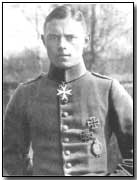Who's Who - Karl Allmenroder
 Karl Allmenroder
(1896-1917) achieved 30 victories as an
air ace
with the German Air Service during the First World War.
Karl Allmenroder
(1896-1917) achieved 30 victories as an
air ace
with the German Air Service during the First World War.
Born in Wald, near Solingen on 3 May 1896 the son of a pastor, Allmenroder appeared destined for a career in medicine shortly before war broke out in August 1914.
Instead he joined Field Regiment 62 before being posted to Field Regiment 20 following initial training, thereafter serving in Poland (out of which he was awarded the Iron Cross 2nd Class in March 1915). Allmenroder was awarded his commission at the end of March 1915.
Along with his brother Willi, Karl applied for a transfer to the Air Service a year later in March 1916; both were successful and were consequently sent for training at Halberstadt, followed by a posting to FA227 and then on to Jasta 11 in November that year, the latter commanded by Manfred von Richthofen.
Allmenroder achieved his total of 30 aerial victories in the period from mid-February to the end of June 1917, including four 'kills' scored in just two days (24-25 May). Awards fell upon Allmenroder with regularity: the Iron Cross 1st Class in March, the Knight's Cross of the Hohenzollern Order in June, and - most prestigiously - the Pour le Merite (or Blue Max) on 7 June.
Allmenroder's brief (if spectacularly successful) aerial career came to an end on 27 June 1917 - the day following his 30th and final victory (a Sopwith Triplane), all achieved with Jasta 11. Flying on patrol in the skies above Zillebeke his aircraft came under fire from Allied aircraft: he was killed when his 'plane crash-landed. A number of honours were conferred upon him posthumously. He was aged 21 at his death.
Click here to read Allenby's account of the fall of Jerusalem in December 1917. Click here to read Allenby's official proclamation of marshal law following the city's fall.
The "linseed lancers" was the Anzac nickname assigned to members of the Australian Field Ambulance.
- Did you know?
